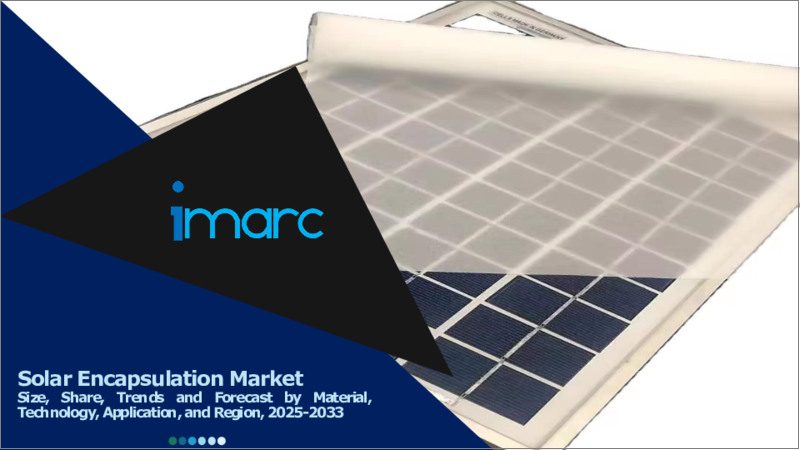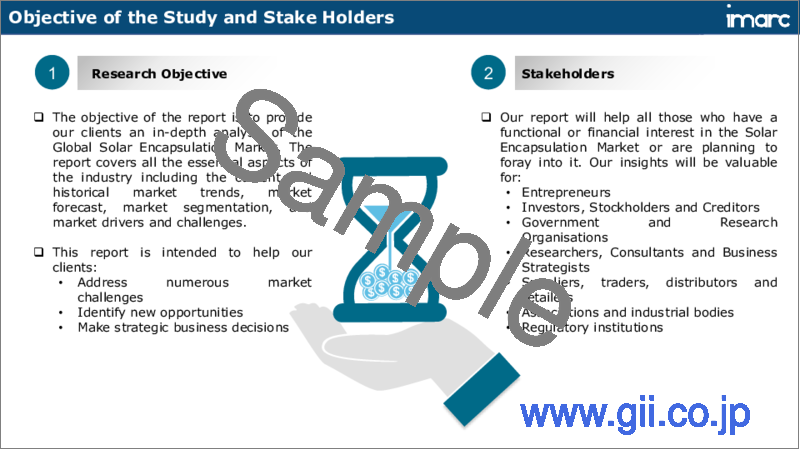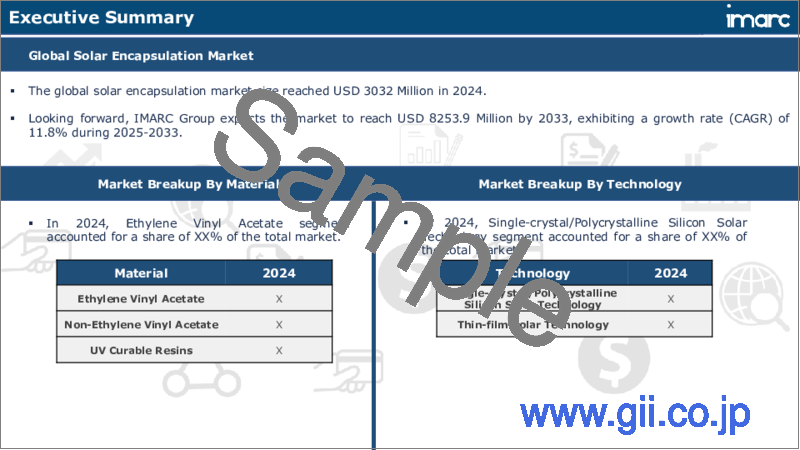|
|
市場調査レポート
商品コード
1722917
太陽電池用封止材の市場規模、シェア、動向、予測:材料、技術、用途、地域別、2025年~2033年Solar Encapsulation Market Size, Share, Trends and Forecast by Material, Technology, Application, and Region, 2025-2033 |
||||||
カスタマイズ可能
|
|||||||
| 太陽電池用封止材の市場規模、シェア、動向、予測:材料、技術、用途、地域別、2025年~2033年 |
|
出版日: 2025年05月01日
発行: IMARC
ページ情報: 英文 136 Pages
納期: 2~3営業日
|
全表示
- 概要
- 図表
- 目次
太陽電池用封止材の世界市場規模は、2024年に30億3,200万米ドルとなりました。今後、IMARC Groupは、2033年には82億5,390万米ドルに達し、2025年から2033年にかけて11.8%のCAGRを示すと予測しています。現在、アジア太平洋地域が市場を独占しており、2024年の市場シェアは60.2%を超えています。同市場は主に、太陽エネルギー導入の高まり、より高い効率と耐久性を実現する太陽電池モジュール製造の大幅な技術進歩、クリーンエネルギーを推進する厳しい政府規制によって牽引されており、太陽電池パネルの性能、寿命、持続可能性を向上させる高度な封止剤への需要を促進しています。
太陽電池用封止材は、さまざまな外部要因や環境要因による劣化からソーラーパネルや機器を保護するために使用される技術を指します。太陽光発電(PV)セルを高分子材料、一般的にはエチレン酢酸ビニル(EVA)フィルムで封止することを含みます。太陽電池の寿命を延ばし、安定性の問題を緩和し、腐食や紫外線(UV)放射、低い機械的応力、温度変化に対する保護を提供するのに役立ちます。また、太陽電池セル、PVモジュールの上面、裏面間の接着にも役立ちます。近年、太陽電池用封止材はPVモジュールの性能、効率、耐久性、費用対効果を高めるのに役立ち、絶大な人気を博しています。
太陽電池用封止材の市場動向:
ソーラーパネルの普及と世界の電力需要の高まりが、市場成長の主な要因となっています。また、環境問題への関心の高まりや従来のエネルギー源の枯渇により、再生可能エネルギーへの転換が進んでいます。これとともに、既存のインフラを近代化するための民間および公共投資の増加が、市場成長の触媒となっています。これに加えて、テルル化カドミウムやアモルファス・シリコン・セルなどの低コストの封止材や、熱可塑性ポリウレタン(TPU)やポリビニルブチラール(PVB)などの非EVAベースの封止材の開発が、製品需要を増大させています。さらに、各国政府によるソーラーパネル設置に関する有利な政策や補助金の実施が、市場の成長を後押ししています。その結果、大手メーカーは新たなPV技術に対応する新しい封止材の開発を進めています。その他、二酸化炭素排出量削減ニーズの高まり、急速な都市化、技術の進歩、発電用太陽エネルギー用途の台頭などが、市場に明るい見通しをもたらしています。
本レポートで扱う主な質問
- 太陽電池用封止材市場の規模は?
- 太陽電池用封止材市場の将来展望は?
- 太陽電池用封止材市場を牽引する主要因は何か?
- 太陽電池用封止材市場で最大のシェアを占める地域は?
- 世界の太陽電池用封止材市場における主要企業は?
目次
第1章 序文
第2章 調査範囲と調査手法
- 調査の目的
- ステークホルダー
- データソース
- 一次情報
- 二次情報
- 市場推定
- ボトムアップアプローチ
- トップダウンアプローチ
- 調査手法
第3章 エグゼクティブサマリー
第4章 イントロダクション
- 概要
- 主要業界動向
第5章 世界の太陽電池用封止材市場
- 市場概要
- 市場実績
- COVID-19の影響
- 市場予測
第6章 市場内訳:材料別
- エチレン酢酸ビニル
- 非エチレン酢酸ビニル
- UV硬化樹脂
第7章 市場内訳:技術別
- 単結晶/多結晶シリコン太陽光発電技術
- 薄膜太陽電池技術
- 主要セグメント
- テルル化カドミウム(CdTe)
- 銅インジウムガリウムセレン(CIGS)
- アモルファスシリコン(a-Si)
- 主要セグメント
第8章 市場内訳:用途別
- 建設
- エレクトロニクス
- 自動車
- その他
第9章 市場内訳:地域別
- 北米
- 米国
- カナダ
- アジア太平洋地域
- 中国
- 日本
- インド
- 韓国
- オーストラリア
- インドネシア
- その他
- 欧州
- ドイツ
- フランス
- 英国
- イタリア
- スペイン
- ロシア
- その他
- ラテンアメリカ
- ブラジル
- メキシコ
- その他
- 中東・アフリカ
- 市場内訳:国別
第10章 SWOT分析
- 概要
- 強み
- 弱み
- 機会
- 脅威
第11章 バリューチェーン分析
第12章 ポーターのファイブフォース分析
- 概要
- 買い手の交渉力
- 供給企業の交渉力
- 競合の程度
- 新規参入業者の脅威
- 代替品の脅威
第13章 価格分析
第14章 競合情勢
- 市場構造
- 主要企業
- 主要企業のプロファイル
- 3M Company
- Bridgestone Corporation
- dnpSolar
- Dow Inc.
- Dupont De Nemours Inc.
- Eastman Chemical Company
- First Solar Inc.
- Kuraray Co. Ltd.
- Mitsubishi Chemical Holdings Corporation
- Mitsui Chemicals Inc.
- RenewSys India Pvt. Ltd.
- STR Holdings Inc.
List of Figures
- Figure 1: Global: Solar Encapsulation Market: Major Drivers and Challenges
- Figure 2: Global: Solar Encapsulation Market: Sales Value (in Million USD), 2019-2024
- Figure 3: Global: Solar Encapsulation Market Forecast: Sales Value (in Million USD), 2025-2033
- Figure 4: Global: Solar Encapsulation Market: Breakup by Material (in %), 2024
- Figure 5: Global: Solar Encapsulation Market: Breakup by Technology (in %), 2024
- Figure 6: Global: Solar Encapsulation Market: Breakup by Application (in %), 2024
- Figure 7: Global: Solar Encapsulation Market: Breakup by Region (in %), 2024
- Figure 8: Global: Solar Encapsulation (Ethylene Vinyl Acetate) Market: Sales Value (in Million USD), 2019 & 2024
- Figure 9: Global: Solar Encapsulation (Ethylene Vinyl Acetate) Market Forecast: Sales Value (in Million USD), 2025-2033
- Figure 10: Global: Solar Encapsulation (Non-Ethylene Vinyl Acetate) Market: Sales Value (in Million USD), 2019 & 2024
- Figure 11: Global: Solar Encapsulation (Non-Ethylene Vinyl Acetate) Market Forecast: Sales Value (in Million USD), 2025-2033
- Figure 12: Global: Solar Encapsulation (UV Curable Resins) Market: Sales Value (in Million USD), 2019 & 2024
- Figure 13: Global: Solar Encapsulation (UV Curable Resins) Market Forecast: Sales Value (in Million USD), 2025-2033
- Figure 14: Global: Solar Encapsulation (Single-crystal/Polycrystalline Silicon Solar Technology) Market: Sales Value (in Million USD), 2019 & 2024
- Figure 15: Global: Solar Encapsulation (Single-crystal/Polycrystalline Silicon Solar Technology) Market Forecast: Sales Value (in Million USD), 2025-2033
- Figure 16: Global: Solar Encapsulation (Thin-film Solar Technology) Market: Sales Value (in Million USD), 2019 & 2024
- Figure 17: Global: Solar Encapsulation (Thin-film Solar Technology) Market Forecast: Sales Value (in Million USD), 2025-2033
- Figure 18: Global: Solar Encapsulation (Construction) Market: Sales Value (in Million USD), 2019 & 2024
- Figure 19: Global: Solar Encapsulation (Construction) Market Forecast: Sales Value (in Million USD), 2025-2033
- Figure 20: Global: Solar Encapsulation (Electronics) Market: Sales Value (in Million USD), 2019 & 2024
- Figure 21: Global: Solar Encapsulation (Electronics) Market Forecast: Sales Value (in Million USD), 2025-2033
- Figure 22: Global: Solar Encapsulation (Automotive) Market: Sales Value (in Million USD), 2019 & 2024
- Figure 23: Global: Solar Encapsulation (Automotive) Market Forecast: Sales Value (in Million USD), 2025-2033
- Figure 24: Global: Solar Encapsulation (Other Applications) Market: Sales Value (in Million USD), 2019 & 2024
- Figure 25: Global: Solar Encapsulation (Other Applications) Market Forecast: Sales Value (in Million USD), 2025-2033
- Figure 26: North America: Solar Encapsulation Market: Sales Value (in Million USD), 2019 & 2024
- Figure 27: North America: Solar Encapsulation Market Forecast: Sales Value (in Million USD), 2025-2033
- Figure 28: United States: Solar Encapsulation Market: Sales Value (in Million USD), 2019 & 2024
- Figure 29: United States: Solar Encapsulation Market Forecast: Sales Value (in Million USD), 2025-2033
- Figure 30: Canada: Solar Encapsulation Market: Sales Value (in Million USD), 2019 & 2024
- Figure 31: Canada: Solar Encapsulation Market Forecast: Sales Value (in Million USD), 2025-2033
- Figure 32: Asia-Pacific: Solar Encapsulation Market: Sales Value (in Million USD), 2019 & 2024
- Figure 33: Asia-Pacific: Solar Encapsulation Market Forecast: Sales Value (in Million USD), 2025-2033
- Figure 34: China: Solar Encapsulation Market: Sales Value (in Million USD), 2019 & 2024
- Figure 35: China: Solar Encapsulation Market Forecast: Sales Value (in Million USD), 2025-2033
- Figure 36: Japan: Solar Encapsulation Market: Sales Value (in Million USD), 2019 & 2024
- Figure 37: Japan: Solar Encapsulation Market Forecast: Sales Value (in Million USD), 2025-2033
- Figure 38: India: Solar Encapsulation Market: Sales Value (in Million USD), 2019 & 2024
- Figure 39: India: Solar Encapsulation Market Forecast: Sales Value (in Million USD), 2025-2033
- Figure 40: South Korea: Solar Encapsulation Market: Sales Value (in Million USD), 2019 & 2024
- Figure 41: South Korea: Solar Encapsulation Market Forecast: Sales Value (in Million USD), 2025-2033
- Figure 42: Australia: Solar Encapsulation Market: Sales Value (in Million USD), 2019 & 2024
- Figure 43: Australia: Solar Encapsulation Market Forecast: Sales Value (in Million USD), 2025-2033
- Figure 44: Indonesia: Solar Encapsulation Market: Sales Value (in Million USD), 2019 & 2024
- Figure 45: Indonesia: Solar Encapsulation Market Forecast: Sales Value (in Million USD), 2025-2033
- Figure 46: Others: Solar Encapsulation Market: Sales Value (in Million USD), 2019 & 2024
- Figure 47: Others: Solar Encapsulation Market Forecast: Sales Value (in Million USD), 2025-2033
- Figure 48: Europe: Solar Encapsulation Market: Sales Value (in Million USD), 2019 & 2024
- Figure 49: Europe: Solar Encapsulation Market Forecast: Sales Value (in Million USD), 2025-2033
- Figure 50: Germany: Solar Encapsulation Market: Sales Value (in Million USD), 2019 & 2024
- Figure 51: Germany: Solar Encapsulation Market Forecast: Sales Value (in Million USD), 2025-2033
- Figure 52: France: Solar Encapsulation Market: Sales Value (in Million USD), 2019 & 2024
- Figure 53: France: Solar Encapsulation Market Forecast: Sales Value (in Million USD), 2025-2033
- Figure 54: United Kingdom: Solar Encapsulation Market: Sales Value (in Million USD), 2019 & 2024
- Figure 55: United Kingdom: Solar Encapsulation Market Forecast: Sales Value (in Million USD), 2025-2033
- Figure 56: Italy: Solar Encapsulation Market: Sales Value (in Million USD), 2019 & 2024
- Figure 57: Italy: Solar Encapsulation Market Forecast: Sales Value (in Million USD), 2025-2033
- Figure 58: Spain: Solar Encapsulation Market: Sales Value (in Million USD), 2019 & 2024
- Figure 59: Spain: Solar Encapsulation Market Forecast: Sales Value (in Million USD), 2025-2033
- Figure 60: Russia: Solar Encapsulation Market: Sales Value (in Million USD), 2019 & 2024
- Figure 61: Russia: Solar Encapsulation Market Forecast: Sales Value (in Million USD), 2025-2033
- Figure 62: Others: Solar Encapsulation Market: Sales Value (in Million USD), 2019 & 2024
- Figure 63: Others: Solar Encapsulation Market Forecast: Sales Value (in Million USD), 2025-2033
- Figure 64: Latin America: Solar Encapsulation Market: Sales Value (in Million USD), 2019 & 2024
- Figure 65: Latin America: Solar Encapsulation Market Forecast: Sales Value (in Million USD), 2025-2033
- Figure 66: Brazil: Solar Encapsulation Market: Sales Value (in Million USD), 2019 & 2024
- Figure 67: Brazil: Solar Encapsulation Market Forecast: Sales Value (in Million USD), 2025-2033
- Figure 68: Mexico: Solar Encapsulation Market: Sales Value (in Million USD), 2019 & 2024
- Figure 69: Mexico: Solar Encapsulation Market Forecast: Sales Value (in Million USD), 2025-2033
- Figure 70: Others: Solar Encapsulation Market: Sales Value (in Million USD), 2019 & 2024
- Figure 71: Others: Solar Encapsulation Market Forecast: Sales Value (in Million USD), 2025-2033
- Figure 72: Middle East and Africa: Solar Encapsulation Market: Sales Value (in Million USD), 2019 & 2024
- Figure 73: Middle East and Africa: Solar Encapsulation Market: Breakup by Country (in %), 2024
- Figure 74: Middle East and Africa: Solar Encapsulation Market Forecast: Sales Value (in Million USD), 2025-2033
- Figure 75: Global: Solar Encapsulation Industry: SWOT Analysis
- Figure 76: Global: Solar Encapsulation Industry: Value Chain Analysis
- Figure 77: Global: Solar Encapsulation Industry: Porter's Five Forces Analysis
List of Tables
- Table 1: Global: Solar Encapsulation Market: Key Industry Highlights, 2024 and 2033
- Table 2: Global: Solar Encapsulation Market Forecast: Breakup by Material (in Million USD), 2025-2033
- Table 3: Global: Solar Encapsulation Market Forecast: Breakup by Technology (in Million USD), 2025-2033
- Table 4: Global: Solar Encapsulation Market Forecast: Breakup by Application (in Million USD), 2025-2033
- Table 5: Global: Solar Encapsulation Market Forecast: Breakup by Region (in Million USD), 2025-2033
- Table 6: Global: Solar Encapsulation Market: Competitive Structure
- Table 7: Global: Solar Encapsulation Market: Key Players
The global solar encapsulation market size was valued at USD 3,032 Million in 2024. Looking forward, IMARC Group estimates the market to reach USD 8,253.9 Million by 2033, exhibiting a CAGR of 11.8% from 2025-2033. Asia Pacific currently dominates the market, holding a market share of over 60.2% in 2024. The market is primarily driven by heightened solar energy adoption, significant technological advancements in solar module manufacturing for higher efficiency and durability, and stringent government regulations promoting clean energy, driving demand for advanced encapsulants that enhance solar panel performance, longevity, and sustainability.
Solar encapsulation refers to the technique used to protect solar panels and equipment against degradation due to various external and environmental factors. It involves encapsulating photovoltaic (PV) cells with a polymeric material, generally ethylene vinyl acetate (EVA) film. It helps extend the life of solar cells, mitigate stability issues, and offer protection against corrosion and ultraviolet (UV) radiation, low mechanical stress, and temperature changes. It also assists in providing adhesion between the solar cells, the top surface, and the rear surface of the PV module. In recent years, solar encapsulation has gained immense popularity as it aids in enhancing the performance, efficiency, durability, and cost-effectiveness of PV modules.
Solar Encapsulation Market Trends:
The widespread adoption of solar panels and the escalating demand for electricity across the globe represent the primary factors driving the market growth. Additionally, there has been a substantial shift toward renewable energy sources due to the growing environmental concerns and depleting conventional energy sources. Along with this, the increasing private and public investments to modernize the existing infrastructure are catalyzing the market growth. Besides this, the development of low-cost encapsulant materials, such as cadmium telluride and amorphous silicon cells, and non-EVA-based encapsulations, including thermoplastic polyurethane (TPU) and polyvinyl butyral (PVB), are augmenting the product demand. Moreover, the implementation of favorable policies and subsidies on the installation of solar panels by governments of various countries is propelling the market growth. As a result, the leading manufacturers are developing new encapsulants for emerging PV technologies. Other factors, including the growing need to reduce carbon footprint, rapid urbanization, technological advancements, and emerging solar energy applications for power generation, are creating a positive outlook for the market.
Key Market Segmentation:
Breakup by Material:
- Ethylene Vinyl Acetate
- Non-Ethylene Vinyl Acetate
- UV Curable Resins
Breakup by Technology:
- Single-crystal/Polycrystalline Silicon Solar Technology
- Thin-film Solar Technology
- Cadmium Telluride (CdTe)
- Copper Indium Gallium Selenide (CIGS)
- Amorphous Silicon (a-Si)
Breakup by Application:
- Construction
- Electronics
- Automotive
- Others
Breakup by Region:
- North America
- United States
- Canada
- Asia-Pacific
- China
- Japan
- India
- South Korea
- Australia
- Indonesia
- Others
- Europe
- Germany
- France
- United Kingdom
- Italy
- Spain
- Russia
- Others
- Latin America
- Brazil
- Mexico
- Others
- Middle East and Africa
Competitive Landscape:
The competitive landscape of the industry has also been examined along with the profiles of the key players being 3M Company, Bridgestone Corporation, dnpSolar, Dow Inc., Dupont De Nemours Inc., Eastman Chemical Company, First Solar Inc., Kuraray Co. Ltd., Mitsubishi Chemical Holdings Corporation, Mitsui Chemicals Inc., RenewSys India Pvt. Ltd. and STR Holdings Inc.
Key Questions Answered in This Report
- 1.How big is the solar encapsulation market?
- 2.What is the future outlook of solar encapsulation market?
- 3.What are the key factors driving the solar encapsulation market?
- 4.Which region accounts for the largest solar encapsulation market share?
- 5.Which are the leading companies in the global solar encapsulation market?
Table of Contents
1 Preface
2 Scope and Methodology
- 2.1 Objectives of the Study
- 2.2 Stakeholders
- 2.3 Data Sources
- 2.3.1 Primary Sources
- 2.3.2 Secondary Sources
- 2.4 Market Estimation
- 2.4.1 Bottom-Up Approach
- 2.4.2 Top-Down Approach
- 2.5 Forecasting Methodology
3 Executive Summary
4 Introduction
- 4.1 Overview
- 4.2 Key Industry Trends
5 Global Solar Encapsulation Market
- 5.1 Market Overview
- 5.2 Market Performance
- 5.3 Impact of COVID-19
- 5.4 Market Forecast
6 Market Breakup by Material
- 6.1 Ethylene Vinyl Acetate
- 6.1.1 Market Trends
- 6.1.2 Market Forecast
- 6.2 Non-Ethylene Vinyl Acetate
- 6.2.1 Market Trends
- 6.2.2 Market Forecast
- 6.3 UV Curable Resins
- 6.3.1 Market Trends
- 6.3.2 Market Forecast
7 Market Breakup by Technology
- 7.1 Single-crystal/Polycrystalline Silicon Solar Technology
- 7.1.1 Market Trends
- 7.1.2 Market Forecast
- 7.2 Thin-film Solar Technology
- 7.2.1 Market Trends
- 7.2.2 Key Segments
- 7.2.2.1 Cadmium Telluride (CdTe)
- 7.2.2.2 Copper Indium Gallium Selenide (CIGS)
- 7.2.2.3 Amorphous Silicon (a-Si)
- 7.2.3 Market Forecast
8 Market Breakup by Application
- 8.1 Construction
- 8.1.1 Market Trends
- 8.1.2 Market Forecast
- 8.2 Electronics
- 8.2.1 Market Trends
- 8.2.2 Market Forecast
- 8.3 Automotive
- 8.3.1 Market Trends
- 8.3.2 Market Forecast
- 8.4 Others
- 8.4.1 Market Trends
- 8.4.2 Market Forecast
9 Market Breakup by Region
- 9.1 North America
- 9.1.1 United States
- 9.1.1.1 Market Trends
- 9.1.1.2 Market Forecast
- 9.1.2 Canada
- 9.1.2.1 Market Trends
- 9.1.2.2 Market Forecast
- 9.1.1 United States
- 9.2 Asia-Pacific
- 9.2.1 China
- 9.2.1.1 Market Trends
- 9.2.1.2 Market Forecast
- 9.2.2 Japan
- 9.2.2.1 Market Trends
- 9.2.2.2 Market Forecast
- 9.2.3 India
- 9.2.3.1 Market Trends
- 9.2.3.2 Market Forecast
- 9.2.4 South Korea
- 9.2.4.1 Market Trends
- 9.2.4.2 Market Forecast
- 9.2.5 Australia
- 9.2.5.1 Market Trends
- 9.2.5.2 Market Forecast
- 9.2.6 Indonesia
- 9.2.6.1 Market Trends
- 9.2.6.2 Market Forecast
- 9.2.7 Others
- 9.2.7.1 Market Trends
- 9.2.7.2 Market Forecast
- 9.2.1 China
- 9.3 Europe
- 9.3.1 Germany
- 9.3.1.1 Market Trends
- 9.3.1.2 Market Forecast
- 9.3.2 France
- 9.3.2.1 Market Trends
- 9.3.2.2 Market Forecast
- 9.3.3 United Kingdom
- 9.3.3.1 Market Trends
- 9.3.3.2 Market Forecast
- 9.3.4 Italy
- 9.3.4.1 Market Trends
- 9.3.4.2 Market Forecast
- 9.3.5 Spain
- 9.3.5.1 Market Trends
- 9.3.5.2 Market Forecast
- 9.3.6 Russia
- 9.3.6.1 Market Trends
- 9.3.6.2 Market Forecast
- 9.3.7 Others
- 9.3.7.1 Market Trends
- 9.3.7.2 Market Forecast
- 9.3.1 Germany
- 9.4 Latin America
- 9.4.1 Brazil
- 9.4.1.1 Market Trends
- 9.4.1.2 Market Forecast
- 9.4.2 Mexico
- 9.4.2.1 Market Trends
- 9.4.2.2 Market Forecast
- 9.4.3 Others
- 9.4.3.1 Market Trends
- 9.4.3.2 Market Forecast
- 9.4.1 Brazil
- 9.5 Middle East and Africa
- 9.5.1 Market Trends
- 9.5.2 Market Breakup by Country
- 9.5.3 Market Forecast
10 SWOT Analysis
- 10.1 Overview
- 10.2 Strengths
- 10.3 Weaknesses
- 10.4 Opportunities
- 10.5 Threats
11 Value Chain Analysis
12 Porters Five Forces Analysis
- 12.1 Overview
- 12.2 Bargaining Power of Buyers
- 12.3 Bargaining Power of Suppliers
- 12.4 Degree of Competition
- 12.5 Threat of New Entrants
- 12.6 Threat of Substitutes
13 Price Analysis
14 Competitive Landscape
- 14.1 Market Structure
- 14.2 Key Players
- 14.3 Profiles of Key Players
- 14.3.1 3M Company
- 14.3.1.1 Company Overview
- 14.3.1.2 Product Portfolio
- 14.3.1.3 Financials
- 14.3.1.4 SWOT Analysis
- 14.3.2 Bridgestone Corporation
- 14.3.2.1 Company Overview
- 14.3.2.2 Product Portfolio
- 14.3.2.3 Financials
- 14.3.2.4 SWOT Analysis
- 14.3.3 dnpSolar
- 14.3.3.1 Company Overview
- 14.3.3.2 Product Portfolio
- 14.3.4 Dow Inc.
- 14.3.4.1 Company Overview
- 14.3.4.2 Product Portfolio
- 14.3.4.3 Financials
- 14.3.4.4 SWOT Analysis
- 14.3.5 Dupont De Nemours Inc.
- 14.3.5.1 Company Overview
- 14.3.5.2 Product Portfolio
- 14.3.5.3 Financials
- 14.3.5.4 SWOT Analysis
- 14.3.6 Eastman Chemical Company
- 14.3.6.1 Company Overview
- 14.3.6.2 Product Portfolio
- 14.3.6.3 Financials
- 14.3.6.4 SWOT Analysis
- 14.3.7 First Solar Inc.
- 14.3.7.1 Company Overview
- 14.3.7.2 Product Portfolio
- 14.3.7.3 Financials
- 14.3.7.4 SWOT Analysis
- 14.3.8 Kuraray Co. Ltd.
- 14.3.8.1 Company Overview
- 14.3.8.2 Product Portfolio
- 14.3.8.3 Financials
- 14.3.8.4 SWOT Analysis
- 14.3.9 Mitsubishi Chemical Holdings Corporation
- 14.3.9.1 Company Overview
- 14.3.9.2 Product Portfolio
- 14.3.9.3 Financials
- 14.3.9.4 SWOT Analysis
- 14.3.10 Mitsui Chemicals Inc.
- 14.3.10.1 Company Overview
- 14.3.10.2 Product Portfolio
- 14.3.10.3 Financials
- 14.3.10.4 SWOT Analysis
- 14.3.11 RenewSys India Pvt. Ltd.
- 14.3.11.1 Company Overview
- 14.3.11.2 Product Portfolio
- 14.3.12 STR Holdings Inc.
- 14.3.12.1 Company Overview
- 14.3.12.2 Product Portfolio
- 14.3.12.3 Financials
- 14.3.12.4 SWOT Analysis
- 14.3.1 3M Company






